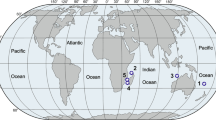Abstract
In ancient Lake Baikal (East Siberia), freshwater sponges have diversified to an extraordinary degree. The skeleton of Lubomirskia baicalensis, which attains a size of up to 1 m, is constructed from spicules, which are cemented into longitudinal bundles. Our X-ray analysis revealed that the architecture of the specimens follows a highly ordered radiate accretive growth pattern. The spicules have a central axial canal with an axial filament inside. This organic filament is composed of silicatein, the major enzyme involved in silica formation of the spicules. We found that the specific activity of silicatein in samples from the non-growing (basal) zone is much lower than in those from the growth zone (tips) and that even the composition of this molecule differs in these regions. The present study shows for the first time that the turnover of silicatein, the major element of the axial canal of sponge spicules, changes within a sponge specimen depending on the region in which it is found.



Similar content being viewed by others
References
Cha JN, Shimizu K, Zhou Y, Christianssen SC, Chmelka BF, Stucky GD, Morse DE (1999) Silicatein filaments and subunits from a marine sponge direct the polymerization of silica and silicones in vitro. Proc Natl Acad Sci USA 96:361–365
Kaandorp JA (1994) Fractal modelling: growth and form in biology. Springer, Berlin Heidelberg NewYork
Kaluzhnaya OV, Belikov SI, Schröder HC, Rothenberger M, Zapf S, Kaandorp JA, Borejko A, Müller IM, Müller WEG (2005) Dynamics of skeletal formation in the Lake Baikal sponge Lubomirskia baicalensis. Part II. Molecular biological studies. Naturwissenchaften 92 in this issue
Masuda Y, Itskovich VB, Veinberg EV, Efremova SM (1997) Studies on the taxonomy and distribution of freshwater sponges in the Lake Baikal. In: Miyzaki N (ed)Animal community, environment and phylogeny in Lake Baikal. Otsuchi Marine Center, Ocean Research Institute, Tokyo
Müller WEG, Krasko A, Le Pennec G, Steffen R, Ammar MSA, Wiens M, Müller IM, Schröder HC (2003) Molecular mechanism of spicule formation in the demosponge Suberites domuncula: silicatein—collagen—myotrophin. Prog Mol Subcell Biol 33:195–22
Müller WEG, Wiens M, Adell T, Gamulin V, Schröder HC, Müller IM (2004) The Bauplan of the Urmetazoa: the basis of the genetic complexity of Metazoa using the siliceous sponges (Porifera) as living fossils. Int Rev Cytol 235:53–92
Pile AJ, Patterson MR, Savarese M, Chernykh VI, Fialkov VA (1997) Trophic effects of sponge feeding within Lake Baikal’s littoral zone. 2. Sponge abundance, diet, feeding efficiency, and carbon flux. Limnol Oceanogr 42:178–184
Savarese M, Patterson MR, Chernykh VI, Fialkov VA (1997) Trophic effects of sponge feeding within Lake Baikal’s littoral zone. 1. In situ pumping rate. Limnol Oceanogr 42:171–178
Schröder HC, Efremova SM, Itskovich VB, Belikov S, Masuda Y, Krasko A, Müller IM, Müller WEG (2003a) Molecular phylogeny of the freshwater sponges in Lake Baikal. J Zool Syst Evol Res41:80–86
Schröder HC, Krasko A, Le Pennec G, Adell T, Hassanein H, Müller IM, Müller WEG (2003b) Silicase, an enzyme which degrades biogenous amorphous silica: contribution to the metabolism of silica deposition in the demosponge Suberites domuncula. Prog Mol Subcell Biol 33:249–268
Scientific Council (1993) Atlas of Baikal. Federal Agency of Geodesy, Maps of Russia, Moscow
Shimizu K, Cha J, Stucky GD, Morse DE (1998) Silicatein alpha: cathepsin L-like protein in sponge biosilica. Proc Natl Acad Sci USA 95:6234–6238
Timoshkin OA (1997) Biodiversity of Baikal fauna: state-of-the-art (preliminary analysis) In: Wada E, Timoshkin OA, Fujita N, Tanida K (eds) New scope on boreal ecosystems in East Siberia. DIWPA series vol. 2. Siberian Branch of the Russian Academy of Science, Novosibirsk, pp 35–76
Timoshkin OA (2001) Index of animal species inhabiting Lake Baikal and its catchment area, vol. 1. Nauka, Novosibirsk
Acknowledgements
We thank Sascha Novitsky (Bolshie Koty) for valuable help in producing the images. This work was supported by grants from the European Commission (INTAS; SILIBIOTEC), WTZ Germany–Russia (German-Russian cooperation through the BMBF) and a grant from the Presidium of the Russian Academy of Science (no. 25.5) and from the RFBR (no. 03-04-49685)
Author information
Authors and Affiliations
Corresponding author
Rights and permissions
About this article
Cite this article
Kaluzhnaya, O.V., Belikov, S.I., Schröder, H.C. et al. Dynamics of skeleton formation in the Lake Baikal sponge Lubomirskia baicalensis. Part I. Biological and biochemical studies. Naturwissenschaften 92, 128–133 (2005). https://doi.org/10.1007/s00114-004-0599-4
Received:
Accepted:
Published:
Issue Date:
DOI: https://doi.org/10.1007/s00114-004-0599-4




